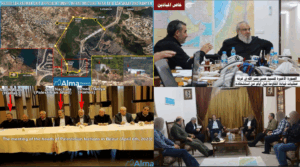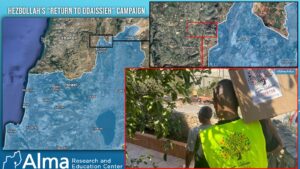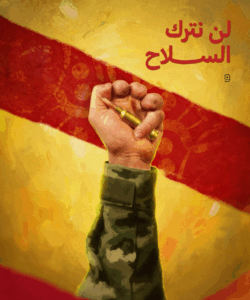By: Tal beeri and Dr. Zoe Levornik.
After months of precise Israeli strikes against Hezbollah’s military infrastructure in the southern Dahieh of Beirut (including bunkers, headquarters, weapons production facilities, and arms depots) located in the heart of civilian areas used as human shields, the extensive destruction inflicted on Hezbollah’s prominent stronghold is beginning to emerge. The reconstruction process is expected to be lengthy and to pose economic, social, and political challenges.
While the Lebanese government fails to provide an adequate response and official institutions shirk responsibility, Hezbollah, who is responsible for turning the area into its military nerve center, attempts to take control and carry out an “independent” reconstruction. However, testimonies from the ground, both from civilians and individuals affiliated with Hezbollah, indicate significant challenges affecting the rebuilding process.
Hezbollah is exploiting its self-directed reconstruction efforts to build military infrastructure underground, under the guise of rehabilitation work. According to several reports, Hezbollah is taking advantage of the destruction to restore underground facilities and weapons storage systems.
Amid the heavy destruction caused, localized and targeted reconstruction efforts have begun in the Dahieh in recent weeks. According to estimates, at least 300 buildings were completely destroyed as a result of the strikes, and many dozens more were partially damaged. This represents an enormous amount of rubble, the removal of which alone is expected to take at least two years.

One of the main problems in the reconstruction process is the issue of funding. The Lebanese government has not been able to activate the $250 million emergency loan from the World Bank, due to reforms that have not yet been implemented. At the same time, the total cost of rebuilding the South, the Dahieh, and the Beqaa is estimated at between 6 and 11 billion dollars, dozens of times more than the financial resources currently available to the government. The official proposal includes raising funds from state funds, re-taxing government assets, involvement of private sectors, and reliance on donations from Lebanese expatriates abroad.
Reconstruction efforts are being carried out in cooperation between the Dahieh Union of Municipalities and local aid organizations, led by “Jihad al-Bina,” Hezbollah’s construction arm. After damage mapping was completed, the buildings were divided into three categories: buildings for complete demolition, buildings for partial demolition, and buildings requiring only reinforcement. The activity also includes immediate assistance to residents in the form of payments for rent and temporary furniture.

According to Mohammad Drah’am, head of the Dahieh Union of Municipalities, out of 299 buildings that were completely destroyed, debris removal has been completed in 249. The repair of basic infrastructure is being carried out solely through local initiatives, without any coordination or support from the government. According to him, what is actually taking place is not genuine reconstruction—but rather patchwork upon patchwork, covering up systemic failure.
Local residents report that dozens of buildings still remain at risk of collapse. Some of them collapsed long after the fighting ended—the most recent one just a few days before writing this article, evidence that no proper repairs were made.
In many parts of the Dahieh, especially in the “American” neighborhood, entire families remain homeless.
Is the Dahieh Emptying Out? A Silent Wave of Migration and Loss of Social Control
A growing phenomenon in the Dahieh is the departure of residents. Many residents who were evacuated from their homes do not intend to return. Some have moved to southern Lebanon, others to the Beqaa, to Christian areas, or abroad. According to various estimates, more than 25% of those evacuated from the Dahieh will not return.
There are many reasons for this: total lack of trust in the state, fatigue from corruption and chaos, and above all, a constant sense of danger. Yet for the most part, the Shiite base, as a captive audience, does not blame the root of the problem—Hezbollah—but looks for other culprits and even defends Hezbollah: “The state has disappeared—as if the war took place in a place that doesn’t belong to it… The authorities focus solely on demanding Hezbollah’s disarmament and offer no real solution for the residents…”
Bureaucracy and Mutual Accusations – Hezbollah Sets the Rules
While the state talks about transparency and “national reconstruction,” in practice – there is not even an official assessment of the damages. Hussein Hajj Hassan, a Member of Parliament on behalf of Hezbollah, accuses the United States and Israel of “linking reconstruction to disarmament.” According to him, as long as political pressures are not removed, “there will be no construction, only minor repairs.”
This approach is also evident on the ground. According to Mohammad Khalil, CEO of “Tardika” (a local company carrying out logistical operations, debris removal, structural reinforcement, and demolition), which operates in the area in cooperation with Hezbollah, the state halted their work, confiscated equipment, and limited working hours. He warns that the scale of destruction is enormous, and the current logistics do not allow for an adequate solution.
Even when work is being carried out it is done without transparency, without oversight, and without a comprehensive vision. Oversight of safety, construction quality, or budget allocation barely exists. Moreover, Hezbollah completely ignores state decisions and continues to manage the area as a separate sovereign entity—a phenomenon that reinforces uncertainty and internal conflicts, and delays the reconstruction process.
Hezbollah’s Economic Challenge
Hezbollah’s economic challenges are particularly evident against the backdrop of the strategic campaign between Israel and Iran, which not only damaged Iran’s military capabilities but also created increasing economic pressure on Tehran, which may need to prioritize the funding of its proxies in the Middle East.
It was recently reported that Iran’s Supreme Leader, Khamenei, instructed that economic resources be prioritized for repairing the damage following the campaign against Israel. The directive is to allocate budgets to the domestic Iranian arena in order to demonstrate to the Iranian public that the regime is capable of dealing with the damage.
However, it appears that at the same time, the regime continues to transfer reconstruction budgets to Hezbollah, primarily for the purpose of restoring buildings and infrastructure that were destroyed in Shiite base areas in Lebanon. From the perspective of the Iranian regime, this is a balancing act between regional commitments and internal obligations. According to our assessment, the majority of this budget is being directed toward the rehabilitation of Hezbollah’s military infrastructure.
The Iranian regime’s decision to continue channeling funds to Hezbollah has provoked internal criticism in Iran.
Meanwhile, it was recently reported that Hezbollah’s financial institution, Al-Qard al-Hassan, announced a freeze on payments until further notice, a clear indication of liquidity difficulties.
In addition, on July 14, 2025, the Bank of Lebanon issued Directive No. 13735, aimed at protecting Lebanon’s financial and economic sector from cooperating with entities that are non-compliant and subject to sanctions by foreign authorities. This is in accordance with Law No. 44 of November 24, 2015, concerning the fight against money laundering and terrorist financing, as well as Laws 170, 182, and 194, the guidelines of the supervisory authority (FATF) on anti-money laundering, and the instructions of the special committee for monitoring suspicious financial activity.
The directive from the Bank of Lebanon states that it is strictly forbidden for all banks and financial institutions in Lebanon to cooperate with any body, institution, or service operating on behalf of or under the mandate of a foreign state that has been designated by international authorities or other countries as illegal or non-compliant. Banks are required to exercise maximum caution in any engagement with foreign entities, especially if there is an indication of an indirect link to bodies subject to international or American sanctions.
Implicitly, this also refers to Hezbollah’s “Al-Qard al-Hassan” bank, although it is not explicitly mentioned by name.
The prohibition includes money transfers, brokerage services, financing, loans, leasing, and any direct or indirect access to the Lebanese banking system in any currency. This comes in response to increasing international pressure, particularly from the United States and European partners, to intensify financial sanctions on Hezbollah’s infrastructure within Lebanon.
In response, on July 19, the management of the “Al-Qard al-Hassan” bank stated in a special announcement to the “Al-Manar” channel that the bank is not subject to the authority of the Bank of Lebanon, and emphasized that it continues to carry out its social and financial missions at an increasing pace and with greater efficiency, despite the recent pressures and measures.
The bank claimed that the directive issued by the Bank of Lebanon, regarding how banks and other financial institutions should conduct themselves in relation to it, is part of a coordinated political campaign led by internal and external actors connected to American agendas, aimed at imposing a siege on the environment that supports the resistance option and attempting to choke the institutions operating in its economic and social circle.
The “Al-Qard al-Hassan” bank stressed its complete rejection of all accusations regarding money laundering or illegal transfers, and clarified that its operations are conducted within the framework defined by the applicable associations law.
While the Lebanese government struggles to manage the reconstruction process in the Dahieh, Hezbollah is trying to take control of the domain in order to protect its interests, Hezbollah’s civil and military reconstruction and the preservation of its base, but the economic challenges present Hezbollah with considerable difficulties.






